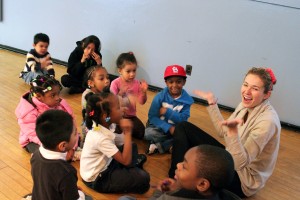Federal initiative helps kids and parents learn healthy eating habits

As eight children sat around a table at East Side House waiting for snacks they played a game of call-and-response.
“Vegetables,” shouted Aaren Kokubun, the group leader.
“Go!” screamed the children.
“Cake,” Kokubun shouted. “Whoa!” came the answer.
The children are participating in a program designed to convince families who live in a community where fast food eateries outnumber playgrounds that they should eat their vegetables and should exercise every day.
Together with the Children’s Museum of Manhattan, the East Side House Settlement Head Start/Day Care launched the Early Childhood Obesity Prevention Program in February 2009.
“The group leaders always come up with wonderful events for the kids to do,” said Zaida Cotto, the mother of four-year-old Madison. “They manage to make it fun for everyone, myself included.”
On vegetable week the children traced Kokubun’s body on butcher paper and colored in cutouts of vegetables. Then Kokubun explained how avocados are good for their hair and carrots improve eyesight. Finally, the children taped the cutouts to the corresponding body part.
“I try to have fun, laugh and be silly,” said Kokubun, who is an educator at the Children’s Museum of Manhattan, “because when the kids see me enjoying myself they want to mimic me.”
The program began with great fanfare when Kathleen Sebelius, the Secretary of Health and Human Services, and Mayor Michael Bloomberg announced a national grant of $838,000 from the Institute of Museum and Library Services and a $250,000 grant from the Laurie M. Tisch Illumination Fund.
It teaches both children and parents about health, nutrition, and portion size, said Sunitha Menon, director of family services at East Side House Settlement Head Start/Day Care.
To get children comfortable with trying new things, East Side House serves them a variety of fruits, including blueberries, blackberries and kiwis.
“When we go shopping my kids bring healthy foods to the cart and tell me we can’t buy too many chips,” said Yolanda Wright, mother of four-year-old Haley and two-year-old Winfred, as she watched her children in the classroom. “I don’t think I’ve ever bought a kiwi before this. But after they tried it here, I have to buy it.”
Each week, the program focuses on a different topic. If it’s vegetable week they’ll have peppers, carrots, celery and broccoli. On the Family Meal week a chef demonstrates how to make soup–typically vegetable or minestrone.
Each week the parents and children review the lessons taught the week before. For example, to show that they understood the “Go, Slow, Whoa” game, the children colored in pictures of different foods then pasted them on a model traffic light.
One child colored a picture of a pancake with a red crayon, pasted it on the traffic light and announced, “Pancakes are a whoa food. Stop eating them.”
Children also participate in an art activity to introduce each day’s lesson and follow it with exercise. One week they built drums to mimic the beat of their hearts. Then they did sets of jumping jacks, listened to their hearts and compared the beat with the drum.
Story-time, too reinforces their lessons.
“I see my kids flipping through the pages of the books and making the connections on their own,” said Wright. “They beg me to read it to them. It’s great.”
The presence and participation of parents is essential, said Menon.
“Children can’t go out and grocery shop on their own,” she said. “By educating parents, they are able to assist their children in living a healthier lifestyle.”
The program was developed for children ages 2 to 5 on the theory that it’s easier to form good habits early in life than to change harmful ones later.
It meets once a week for 90 minutes, and runs for 11 weeks, serving a total of about 40 children at a time at the East Side House Settlement Head Start/Day Care program sites: Mott Haven Community Center, Mill Brook Community Center and Children’s Pride.
Because the government hopes the program will serve as model to be duplicated nationwide, before and after each 11-week session, workers at East Side House interview the families in an effort to learn whether the program has led them to change.
“We realize that there are people who can’t get all the resources they need,” said Kokubun. “It’s not their fault. We go to where the families live rather than have them come to us because everyone deserves an equal opportunity.”

[…] Bufano’s article about a program that encourages kids to eat their vegetables and exercise found a home in the Mott Haven Herald. Alum Joe Hirsch wrote about concerns over […]